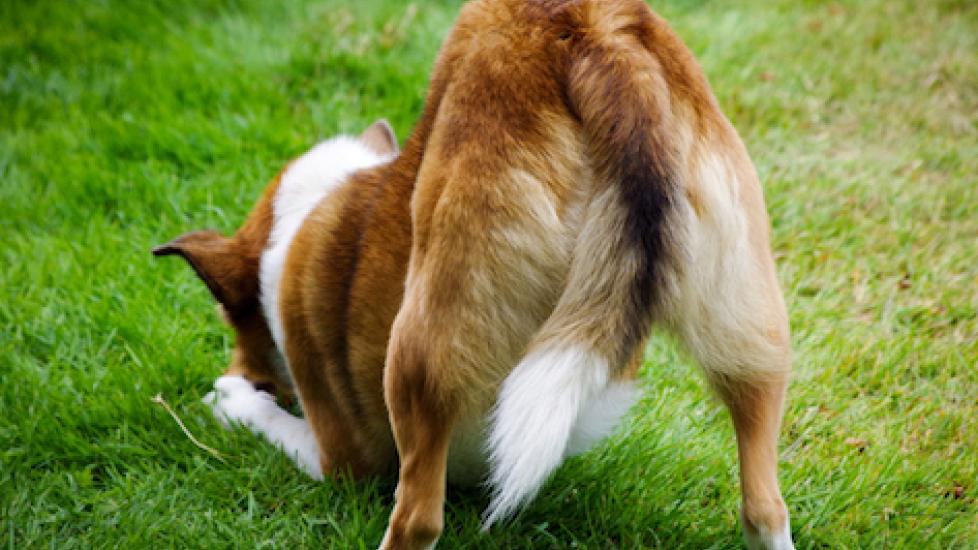Can Dogs Get Hemorrhoids?
By Sarah Wooten, DVM
In humans, a hemorrhoid is defined as a swollen blood vessel in the lower rectum or anus. They can be internal or protrude externally, and can range from very painful to mildly uncomfortable—a real pain in the you know where.
Fortunately for dogs, they don’t get hemorrhoids because the anatomy of their gastrointestinal system is different than humans. For one, they walk around on four feet, and we walk around on two. Our lower GI system runs more vertical, predisposing us to problems with hemorrhoids, but dogs’ lower GI system runs horizontally, putting less pressure on the blood vessels in the rectum and anus.
Problems Mistaken for Hemorrhoids in Dogs
Even though dogs don’t get hemorrhoids, they can get other problems in their nether regions that you as their pet parent need to be aware of, such as anal tumors, a prolapsed rectum, or anal gland problems.
Anal Gland Problems
Unlike humans, dogs have two scent glands in their anus. Normally, the glands secrete liquid material into two sacs located in their anus at the 4 and 7 o’clock positions. These glands are leftover structures from the wild ancestors of dogs, and served to mark territories or were expressed when the dog was frightened or angry. You may have smelled when your dog expressed his anal glands. (The odor is very, shall we say, distinctive and difficult to eliminate from shoes and other surfaces.)
For most animals, anal glands are never a problem, but some dogs really struggle with anal sac problems related to an inability to express the glands normally. Sometimes, after a dog has had a bout with diarrhea and straining, they can develop anal gland issues. The glands fill to capacity, become infected and inflamed, and, in some cases, abscess and rupture, draining out pus and anal sac liquid. It’s not pleasant.
Pet parents can easily tell when their dog is having an anal gland problem. An affected dog will drag his butt around on the ground or lick his hind end excessively. You may also smell the noxious fumes from the anal glands. Inflamed and infected anal sacs are often mistaken for hemorrhoids in dogs. Inflamed, infected, or overly full anal glands are painful. If you see your dog showing any of these signs, it is time to get him to the veterinarian. Treatment can include expression of the anal glands, anti-inflammatories, antibiotics, and photobiomodulation (cold laser therapy). If your dog is very painful, he may require a mild sedation for treatment.
Most dogs recover uneventfully from anal sac issues, but some dogs may require their anal glands to be expressed several times after to “get them going again normally,” or they may have an anatomic abnormality that prevents normal expression and require anal gland expression on a regular basis, either at the veterinary hospital or at the groomer.
Some dogs may benefit from added fiber to their diet to bulk up stool volume, the idea being that thicker stool will compress the rectum, anus, and anal glands more, encouraging the anal sacs to empty when the animal defecates. You could try adding in 1 to 3 tablespoons of canned pumpkin, or switch your dog to a therapeutic diet formulated with added fiber for this very condition. Talk with your veterinarian about product recommendations.
Prolapsed Rectum
Another condition that can be confused with hemorrhoids is a prolapsed rectum, or rectal prolapse. A rectal prolapse happens when the internal parts of the anus and rectum protrude out the opening of the anus. It can either be partial, where the condition subsides after defecation, or complete, where a mass of reddened tissue protrudes persistently, and may be darkly discolored.
Dogs who are suffering from rectal prolapse will continually strain to defecate. Diarrhea, intestinal parasites, urinary disorders, or chronic constipation can all cause rectal prolapse. A complete rectal prolapse is an emergency and requires immediate veterinary attention. A partial prolapse, where the tissue disappears after defecation, still requires veterinary attention as soon as possible, but can wait 24 hours as long as the condition does not deteriorate into a complete prolapse.
Image via Morlaya/Shutterstock
